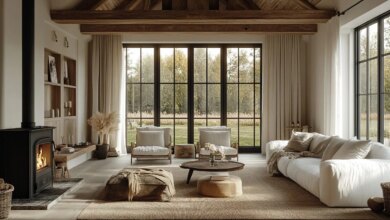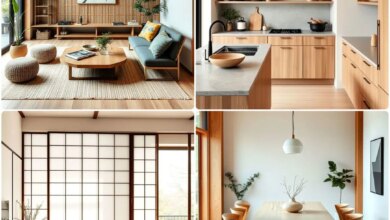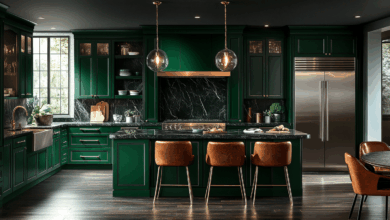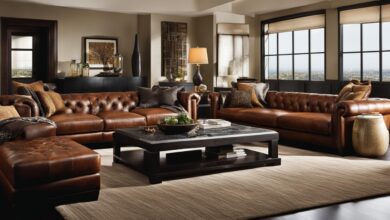19 Must-Know Principles for Creating a Truly Authentic Minimalist Bedroom
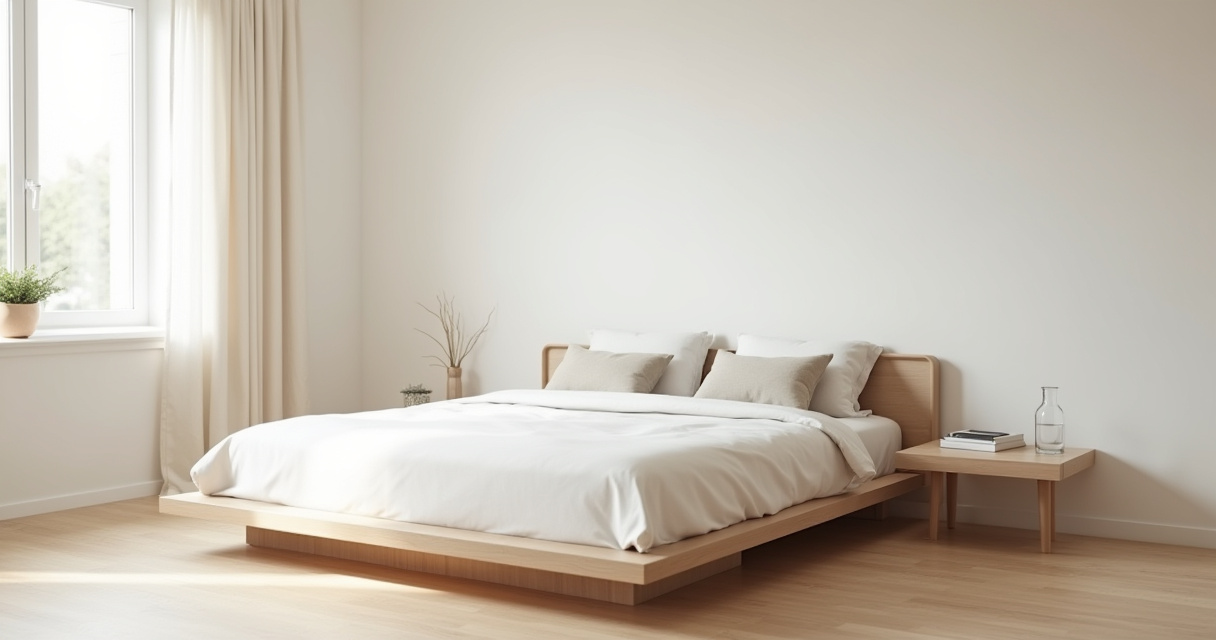
One question I frequently encounter is, “How can anyone comfortably live in those stark, all-white rooms labeled as ‘minimalist’ in magazines?” This misconception frustrates me because what they’re seeing isn’t true minimalism-it’s a cold, impersonal showroom.
Authentic minimalism, a concept I embraced through my Middle Eastern heritage and studies in Scandinavia, transcends mere emptiness. It embodies tranquility. Imagine a traditional riad in Fes: outside, the streets buzz with vibrant chaos, but stepping through a modest wooden door reveals a serene courtyard. Sparse elements-a fountain, a few cushions, detailed tilework-fill the space with calm and shelter. This sanctuary harmonizes with its surroundings. That’s the essence we aim to capture. Minimalism isn’t about owning less; it’s about enriching the meaning of what you keep. Let’s move beyond corporate jargon like “space optimization” and focus on crafting a room that truly breathes with you.
Core Concepts & Strategic Preparation for Tranquil Living (Part 1)
Before purchasing your first linen pillowcase, it’s crucial to establish a solid foundation. This preparatory phase is often overlooked but is the cornerstone of a peaceful environment. A genuinely calming space results from deliberate, thoughtful choices that respect the room’s purpose: rest. Think of it as nurturing soil before planting a garden.
This process involves eliminating clutter not only physically but mentally. By setting a robust base, every subsequent decision will feel intuitive and harmonious, enhancing serenity rather than adding disorder. The goal is to design a space that serves your needs, not the other way around.
1. Perform an Honest, Comprehensive Decluttering of Your Bedroom
Forget tedious checklists that have you sorting insignificant items. This step demands sincere self-reflection. What in your bedroom genuinely contributes to your peace? In arid regions, every possession must have a purpose because carrying excess is a burden. Adopt this mindset. You’re not just clearing space; you’re creating room for light, air, and mental clarity.
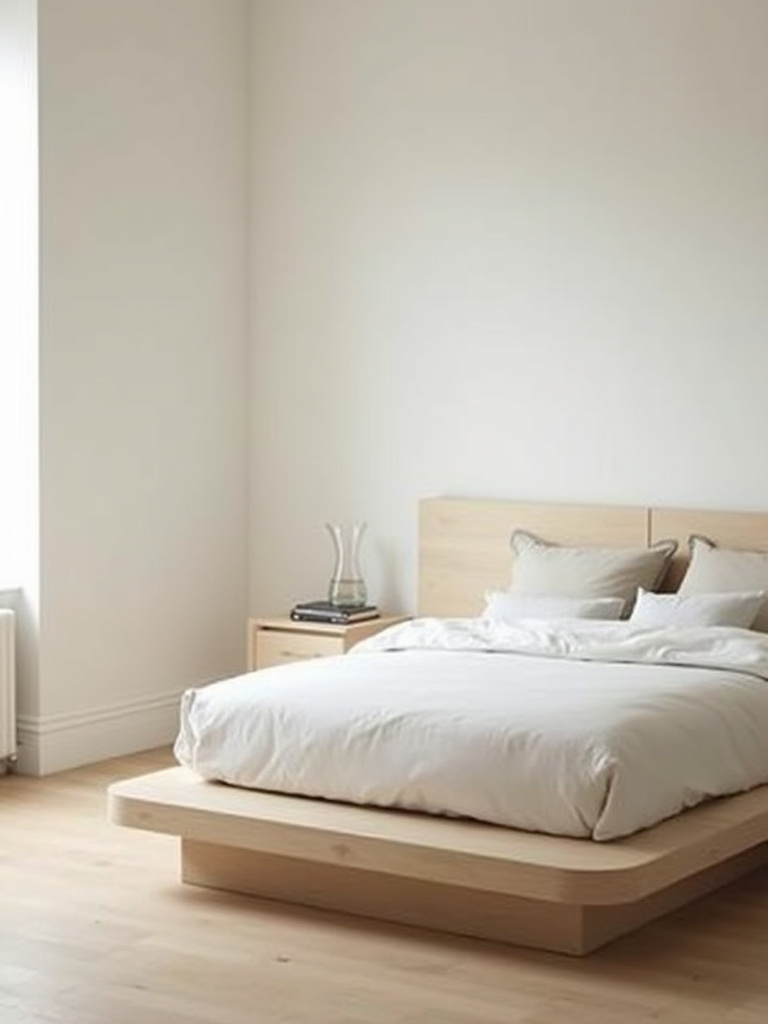
Shift your question from “Does this spark joy?” to “Does this support my rest?” That ticking antique clock from your aunt? It disrupts your sleep. The stack of work papers on your chair? It undermines your calm. Be uncompromising in protecting your tranquility. The aim isn’t an empty room but one where every item quietly nurtures your well-being.
Recognizing what truly aids your rest reveals how minimal your needs are. Though challenging, this step is liberating and sets the tone for all that follows.
2. Identify Your Unique Minimalist Aesthetic and Harmonious Color Scheme
Many equate minimalism with endless shades of gray and white. While that palette suits some, I find inspiration in nature’s subtle richness. Picture the desert at dawn: warm sand hues, muted mountain blushes, soft greens of resilient succulents, and earthy terracotta tones. These colors ground and soothe.
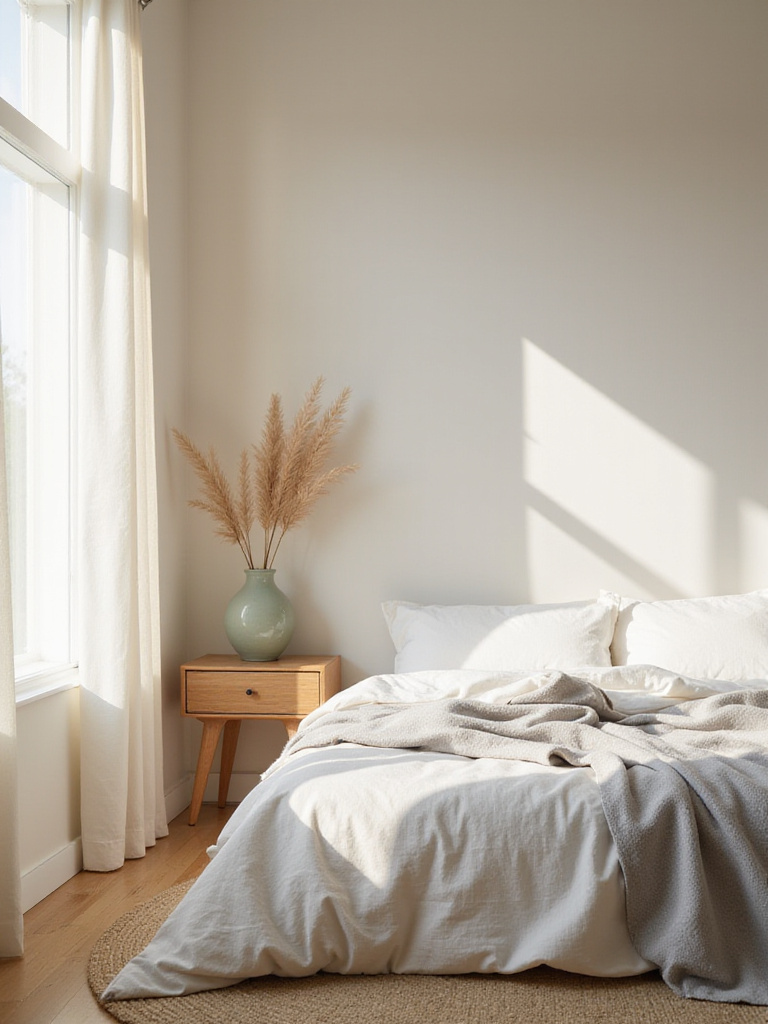
Your color palette should evoke a deep, calming breath, drawn from landscapes that bring you peace. Observe tree bark, stone paths, or post-storm skies. Select 3-4 muted, natural tones to form your core palette. This approach isn’t about trends but about cultivating a mood. For example, a client inspired by the Pacific Northwest chose stone gray, moss green, and warm cedar brown, transforming her bedroom into a tranquil forest retreat.
With a defined palette, decision-making simplifies. Instead of endless options, you select from a curated set that fosters harmony.
3. Assess Your Bedroom Layout to Enhance Flow and Spaciousness
In Middle Eastern architecture, the flow between spaces is vital. Moving from a sunlit courtyard to a shaded room is a deliberate transition. Your bedroom should offer a similar seamless journey. The true luxury of minimalism lies in uncluttered space. Negative space allows your eyes and mind to rest.
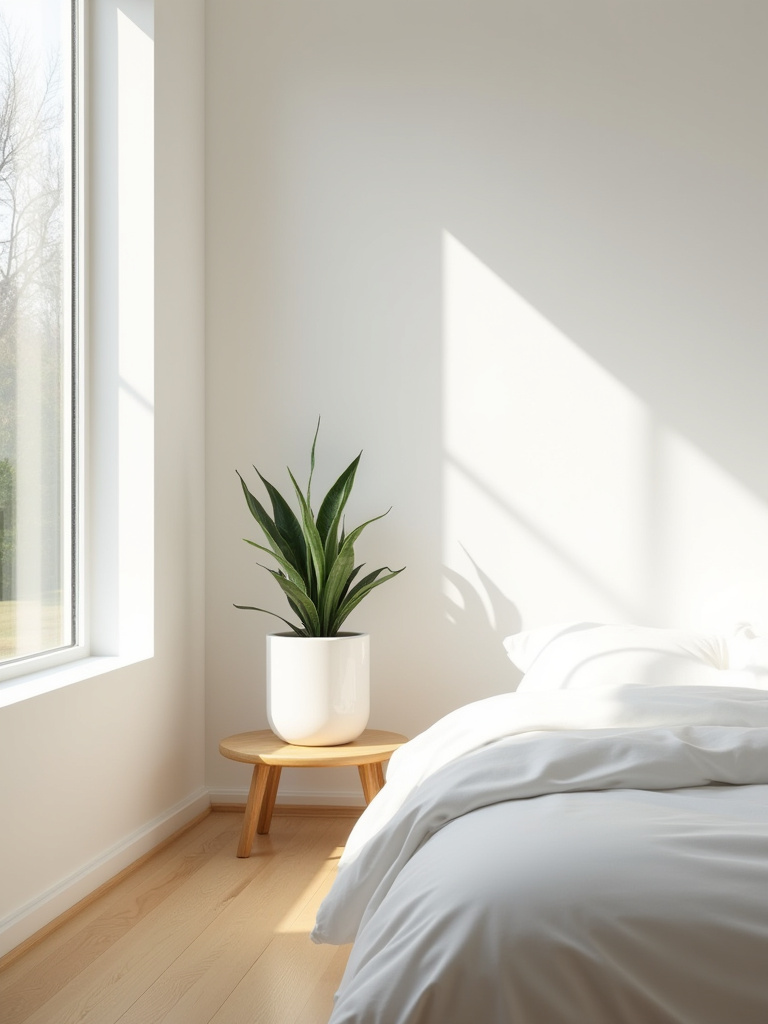
Sketch your room and trace your daily paths-from door to bed, bed to closet. Are these routes unobstructed, or do you weave around oversized furniture? Arrange pieces to support natural movement, creating an intuitive, open layout that feels like a gentle glide.
Prioritizing flow not only enlarges the perceived space but also improves air circulation-a key aspect of eco-conscious design that keeps your room fresh and comfortable.
4. Choose Functionality Over Aesthetics for Every Essential Item
Here’s a candid truth: many “design objects” are merely decorative clutter. Both Scandinavian and desert cultures prize beauty intertwined with utility. A hand-carved wooden spoon, a finely woven textile, or a simple clay water vessel are admired for their purposeful elegance. This principle should guide every bedroom choice.
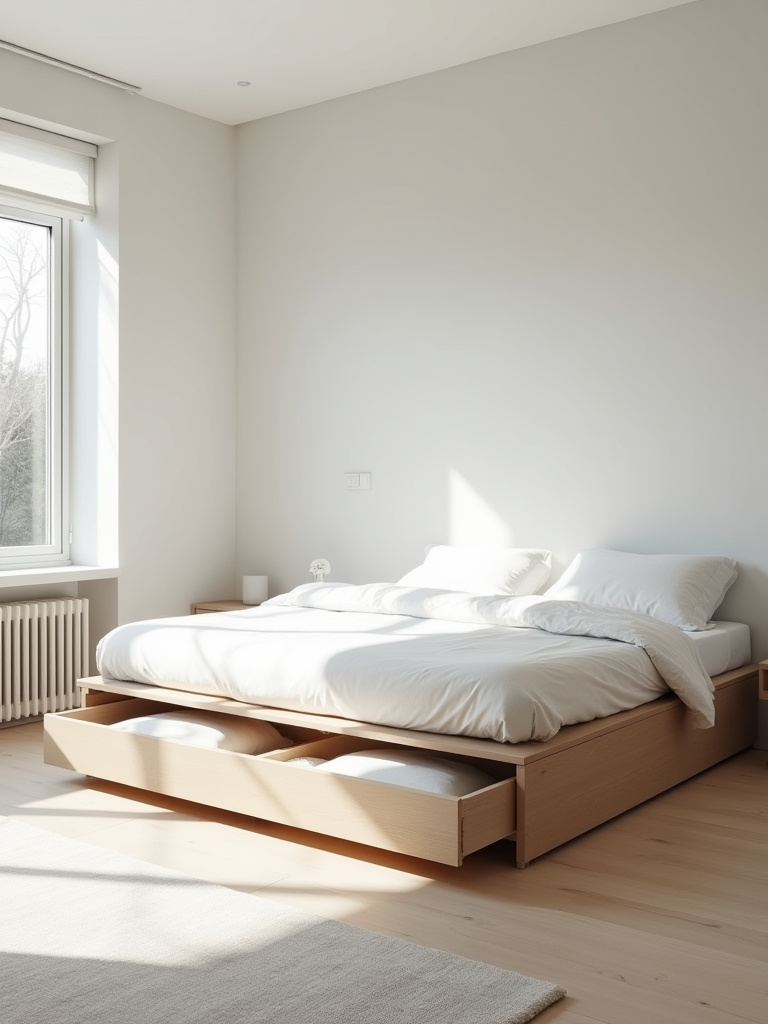
Before acquiring anything, ask: What is its primary role? Does it fulfill that role simply and beautifully? Your bed should offer a stable, quiet foundation for sleep. Nightstands hold only essentials within reach. Lamps provide appropriate light for reading or relaxation. Items without clear, necessary functions have no place in your sanctuary.
For instance, a client once had an ornate chair that was uncomfortable and became a clothes dump. We replaced it with a simple wooden bench that served as seating and concealed storage for an extra blanket-two functions, zero clutter. That’s the ideal.
Core Concepts & Strategic Preparation for Tranquil Living (Part 2)
With the foundation laid, the focus shifts from a one-time overhaul to ongoing mindful maintenance. Minimalism is a lifestyle, not a project. Like tending a garden, it requires regular care-pruning and weeding to preserve its vitality. This practice safeguards the calm you’ve cultivated.
This next principle acts as a protective measure against the relentless urge to accumulate. It transforms minimalism from a design choice into a sustainable way of living, ensuring your bedroom remains a peaceful refuge over time.
5. Adopt a “One-In, One-Out” Policy for New Items
This isn’t about restriction but about intentional curation. It empowers you to become an active steward of your belongings. Committing to remove an item each time you add something new encourages thoughtful decisions. Impulse purchases or trendy decor must prove their worth by surpassing the value of what they replace.
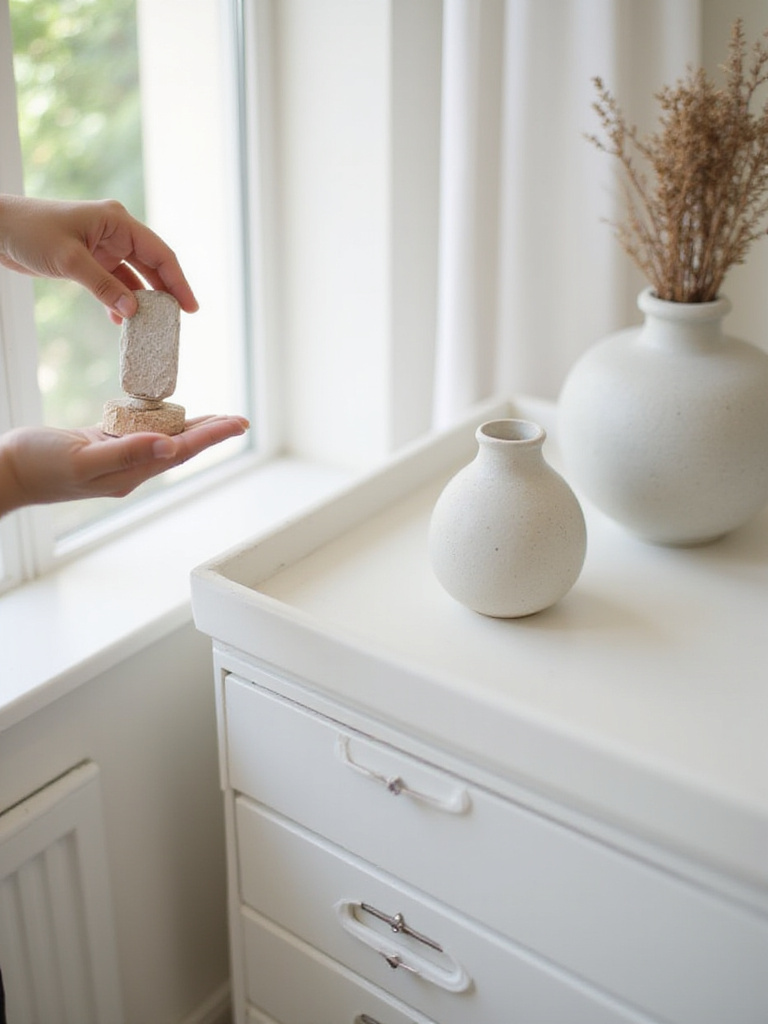
Usually, the new item isn’t worth it. This habit slows the influx of possessions and fosters intentionality. Before buying a new book, I consider which one I’m ready to share. Before acquiring a new vase, I reflect on the cherished one I already own. This balance honors your current belongings while thoughtfully welcoming new additions.
This simple discipline is the cornerstone of enduring tranquility. Without it, even the most carefully designed minimalist room will gradually fill with clutter.
Essential Furniture & Intelligent Storage Choices (Part 1)
Now, let’s discuss furniture. These substantial pieces anchor your sanctuary and must be simple, functional, and crafted from authentic materials. They shouldn’t demand attention but provide a quiet, sturdy foundation for the space.
Think of each item as a character in a narrative, playing its role flawlessly without overshadowing others. This section focuses on selecting your core ensemble-the bed, storage units, and bedside surfaces-with care and foresight.
6. Choose a Durable, Minimalist Bed Frame of Superior Quality
The bed is the room’s centerpiece and deserves no compromise. Avoid ornate, bulky headboards that dominate. Opt for a simple platform bed made from solid wood like oak, walnut, or maple. The natural grain and warmth of wood add organic texture, preventing a cold atmosphere.
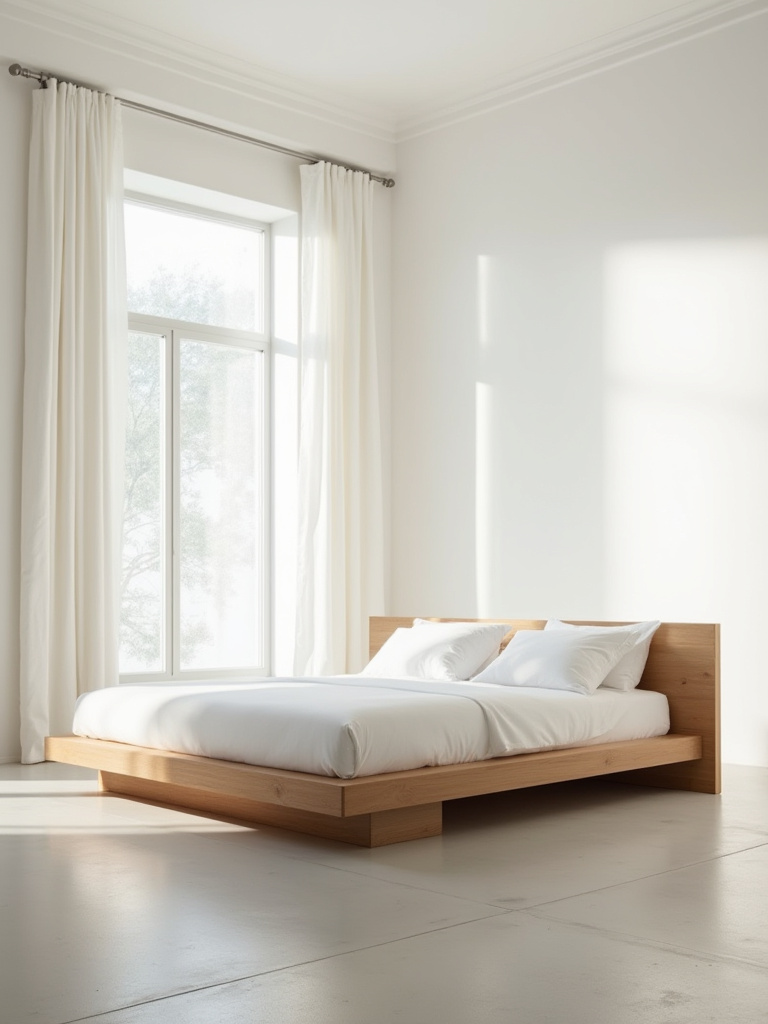
A low-profile design enhances openness, making ceilings feel higher and the room more spacious. It also grounds the space, fostering stability and calm. Silence and sturdiness are paramount; a creaky frame disrupts rest. I advise investing generously in a quality mattress and a simple, robust frame-your most vital wellness investment.
The bed’s role is to elevate your mattress discreetly, allowing your rest to take center stage.
7. Opt for Multifunctional Furniture to Enhance Practicality
This concept stems from ancient necessity. In nomadic or compact living, every item had to serve multiple purposes. A wooden chest might store textiles and double as seating. We can apply this wisdom today.
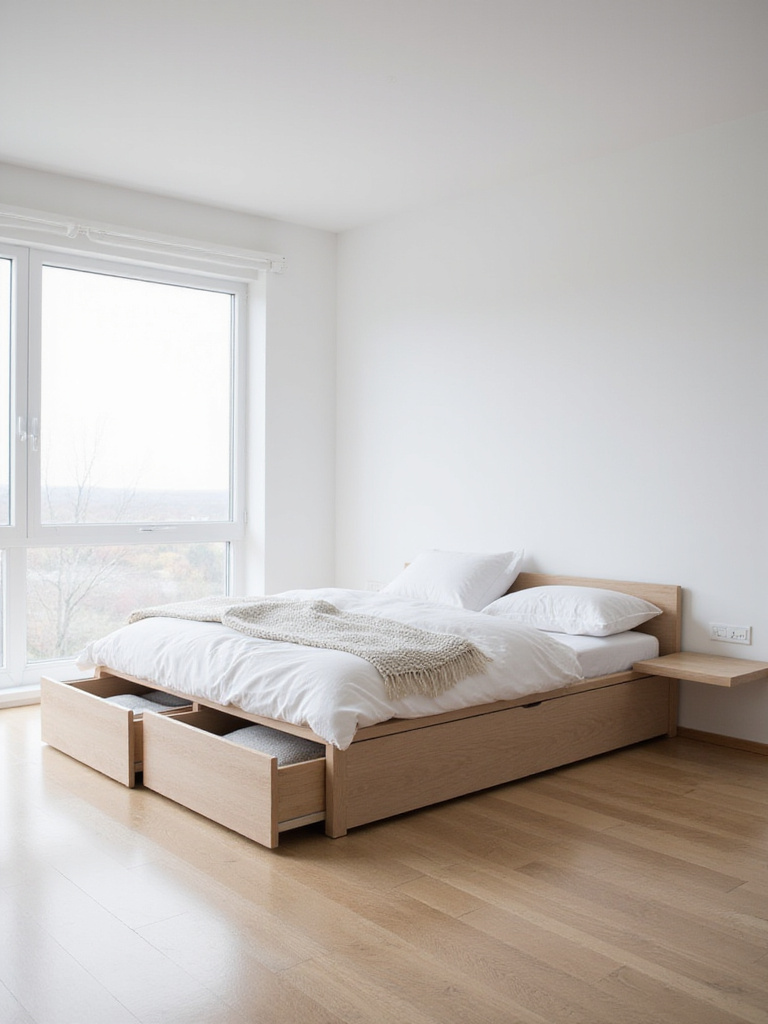
Seek furniture that combines roles. Can your bed frame include drawers, replacing a dresser? Can a bench at the foot of the bed store linens? In smaller rooms, this strategy is essential for preserving openness, providing function without crowding.
By selecting pieces that multitask, you reduce quantity and visual clutter, creating a more peaceful environment.
8. Favor Closed Storage to Hide Clutter
Inspired by the mashrabiya-intricate lattice screens in Islamic architecture that provide privacy while allowing air and light flow-your storage should conceal visual clutter behind calm, uniform surfaces.
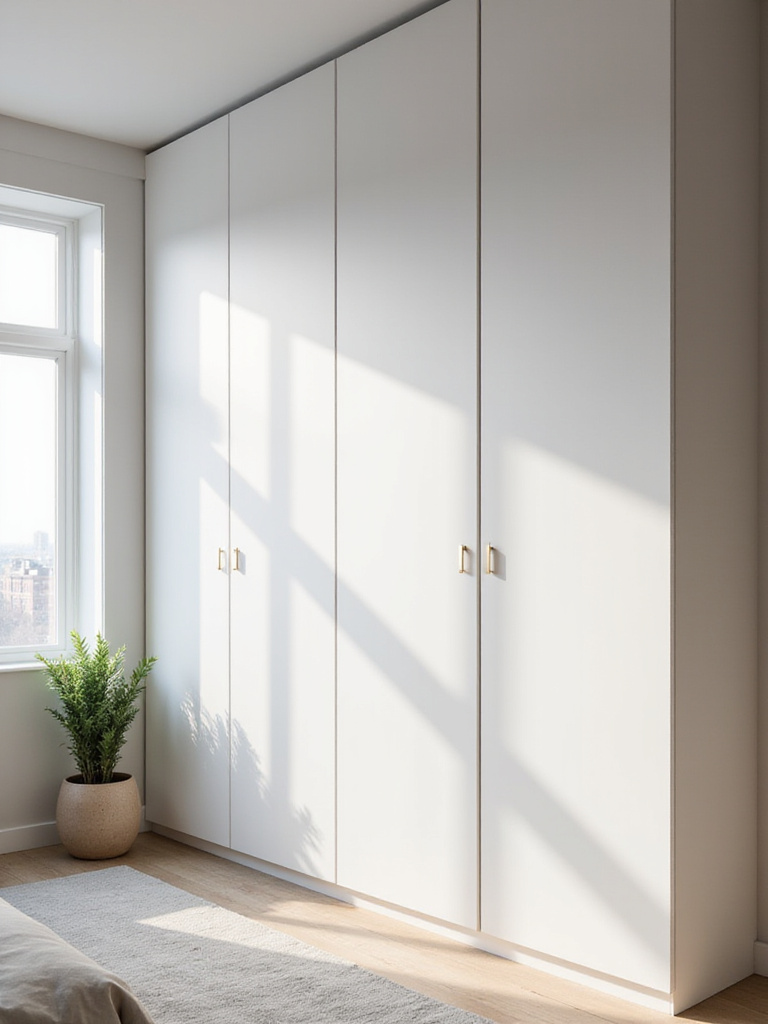
Even well-organized open shelves can feel chaotic because your eyes process every item. Closed storage-like dressers with flat fronts or wardrobes with solid doors-creates a clean, uninterrupted surface, instantly calming the room. This isn’t about hiding mess but providing a serene home for your belongings. The exterior should be minimal and peaceful, while the interior remains functional and orderly.
I recommend storage that blends with the wall color and features minimal hardware, allowing it to fade into the background and enhance spaciousness.
9. Select Simple, Functional Nightstands or Floating Shelves
The area beside your bed is sacred, reserved for essentials that ease your transition to sleep and waking. Avoid bulky nightstands that attract clutter-old glasses, cords, stacks of books. The surface should accommodate only what you truly need: a small lamp, a water glass, perhaps one book.
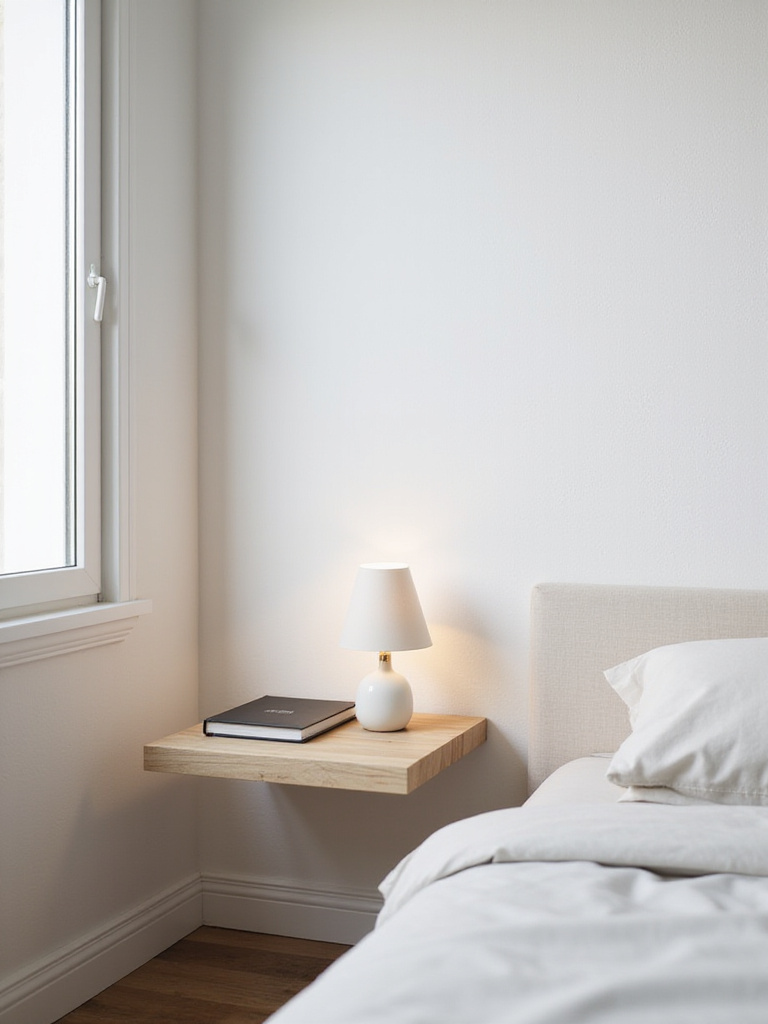
I strongly favor floating shelves over traditional nightstands. They keep floor space clear, visually expanding the room and simplifying cleaning-especially beneficial in dusty climates. A simple wooden shelf mounted on the wall often suffices. If storage is needed, a floating nightstand with a small drawer can discreetly hold essentials like lip balm or glasses.
This choice reinforces the bedroom as a functional sanctuary, not a storage area. Keeping the space around your head uncluttered profoundly enhances peace of mind.
Essential Furniture & Intelligent Storage Choices (Part 2)
Having selected your foundational pieces, the next challenge is restraint. Modern design often defaults to filling every empty space with furniture. True minimalism embraces the luxury of empty walls and open areas, celebrating calm and breathing room.
This mindset shift is more philosophical than practical. It requires valuing open, unburdened space as a profound luxury. Though difficult for many, this restraint distinguishes a truly serene room from one that is merely tidy.
10. Avoid Overfurnishing by Keeping Only What’s Necessary
In warm climates, space itself cools. Excess furniture retains heat, while open areas allow air to circulate, making the room feel fresher and more breathable. This climate-aware principle underscores the importance of resisting the urge to fill every corner. Negative space is functional and vital.
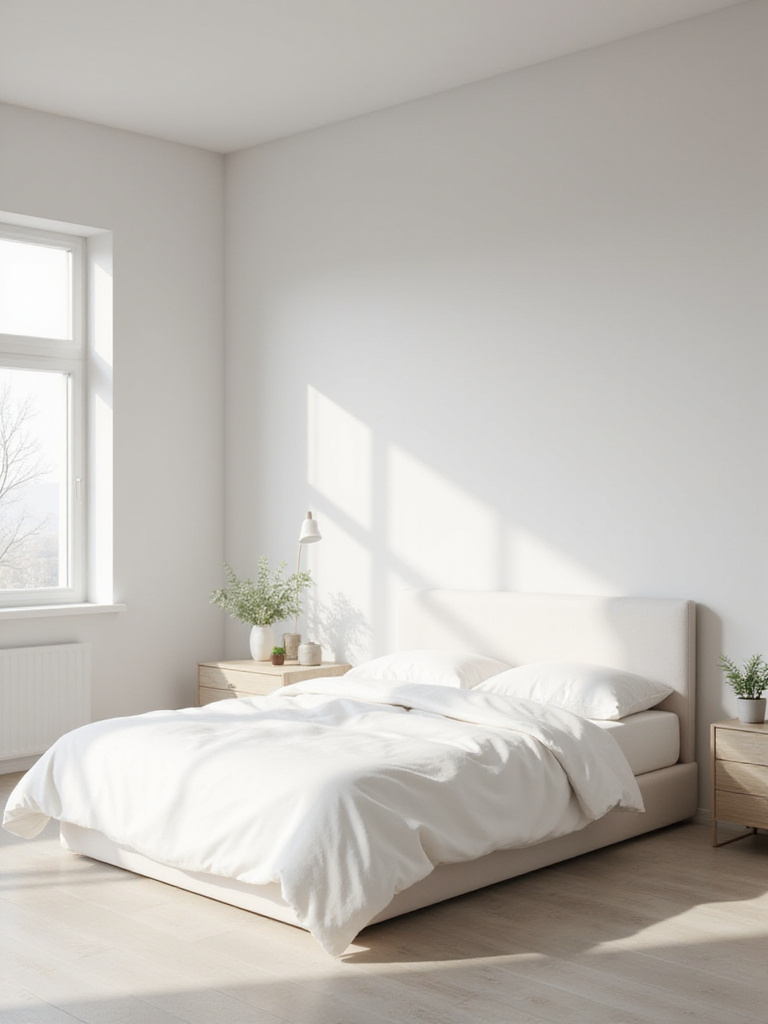
Once you have your essentials-the bed, core storage, nightstand-pause. Live in the space before adding extras like a reading chair or dresser. An empty corner isn’t a problem; it’s an invitation to calm. Often, you’ll find nothing more is needed.
One transformative experience for a client was simply removing half the furniture-no additions, just subtraction. Eliminating an unnecessary dresser, two chairs, and a large bookcase doubled the room’s perceived size and created a space where true relaxation was possible.
Intentional Styling, Lighting & Sensory Enhancements (Part 1)
With a clear, purposeful base, we can now infuse the room with warmth, character, and personality-always with intention. This phase isn’t about decoration but about layering sensory elements that deepen the sanctuary’s essence.
Light, texture, art, and living elements prevent minimalism from feeling sterile. These details personalize the space, transforming it from a well-designed room into a heartfelt refuge.
11. Maximize Natural Light with Simple, Sheer Window Treatments
Light is your most valuable design asset-and it’s free. However, it requires thoughtful management. Scandinavian design often favors bare windows to maximize light, but in sun-intense regions, this isn’t practical. Instead, we borrow from desert traditions, filtering and softening light to create a gentle indoor glow.
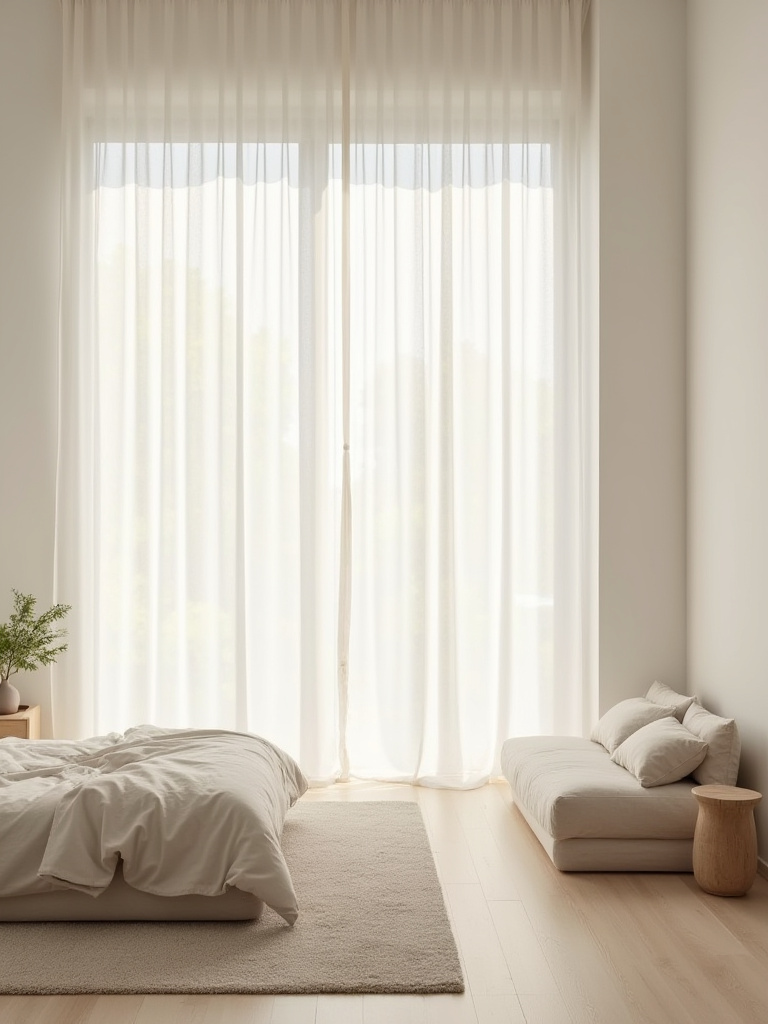
Skip heavy drapes. Opt for sheer linen panels that provide privacy while diffusing sunlight, softening shadows, and reducing glare. Their gentle movement with the breeze adds life. Install curtain rods high and wide, extending beyond the window frame, so curtains can be fully drawn aside, maximizing light when desired.
Your window treatments should be subtle tools for shaping light and mood, not bold statements.
12. Incorporate Thoughtful Textures to Add Warmth and Dimension
Texture is the antidote to cold minimalism. When colors are muted and furnishings simple, tactile variety breathes life into a room. I encourage clients to imagine touching every surface-what sensations arise?
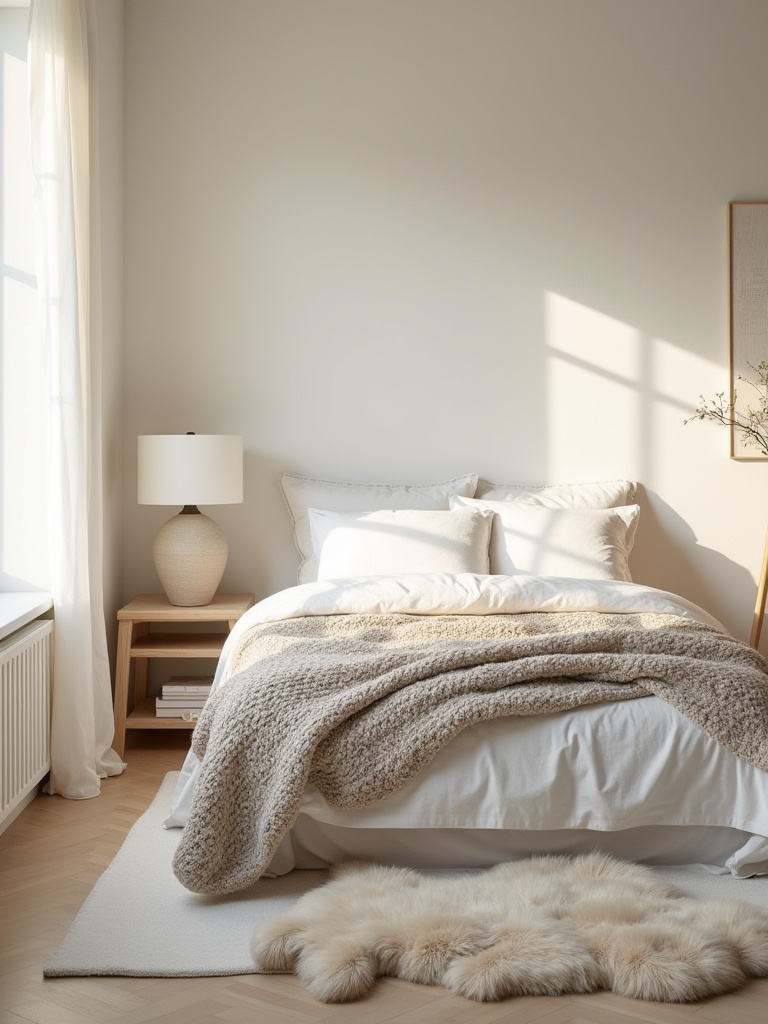
Layer natural materials generously: a chunky wool throw atop crisp linen sheets, a handmade ceramic vase’s roughness, the cool smoothness of plaster walls, or the soft patina of a vintage kilim rug. These contrasts-rough and smooth, soft and hard-imbue the space with soul.
Both Scandinavian and Middle Eastern designs share a reverence for honest, natural materials that tell stories and engage the senses.
13. Choose Select Meaningful Artworks as Visual Anchors
Avoid generic “hotel art” used merely to fill walls. Art in a minimalist sanctuary should be deeply personal and applied sparingly. One large piece you cherish is more impactful than a cluttered gallery wall. Art should invite contemplation and evoke quiet joy or peace.
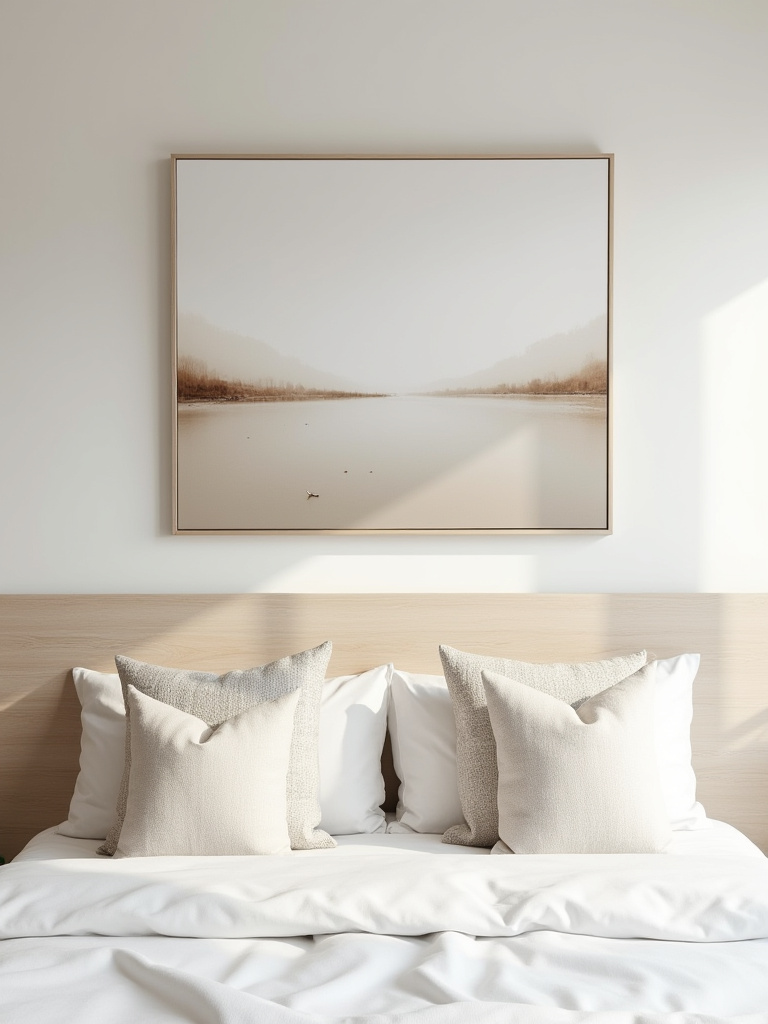
Art need not be a painting; it could be framed calligraphy, a large photograph from a meaningful journey, or a textile hung on the wall. Give the piece space to breathe-don’t crowd it. Let it be the star of its wall.
A client once felt newfound calm after replacing seven small pictures with a single large abstract canvas. “My eyes finally knew where to rest,” she said. That’s the power of thoughtful art.
14. Add Carefully Chosen Greenery for Vitality
Every room benefits from a living element, connecting us to nature and symbolizing growth. But like art, restraint is key. Avoid dense indoor jungles; select one or two sculptural plants.
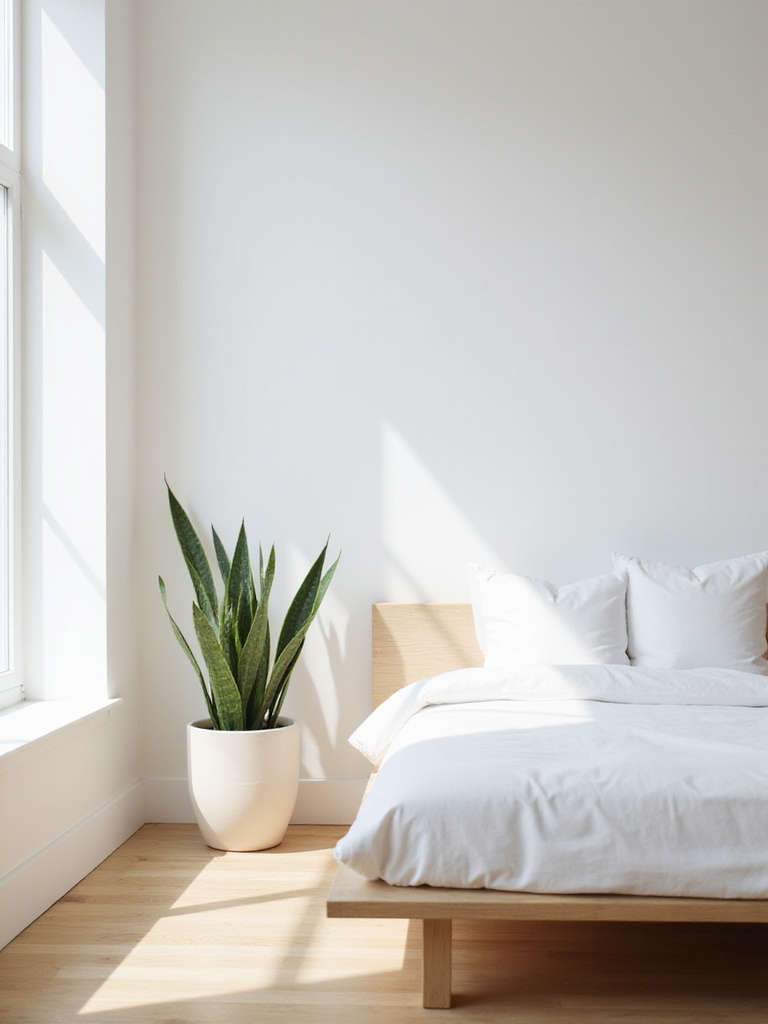
In line with climate-conscious design, I favor hardy, low-water plants like Snake Plants or ZZ plants, whose clean lines complement minimalist decor. An olive tree in a simple terracotta pot can also make a striking statement if lighting permits. The pot itself matters-choose simple, natural materials like ceramic, stone, or concrete that harmonize with your palette.
Position plants where their form can be appreciated, such as a corner softening architectural lines or a dresser adding organic life. This subtle detail profoundly enhances the room’s ambiance.
Intentional Styling, Lighting & Sensory Enhancements (Part 2)
Beyond visible elements, lighting profoundly shapes a room’s atmosphere. Poor lighting can make even the most elegant space feel harsh and stressful. The final sensory layer is crafting a lighting scheme that aligns with your natural rhythms and fosters evening calm.
This involves more than selecting attractive fixtures; it requires understanding light’s psychological impact to prepare your mind and body for rest.
15. Select Minimalist Lighting Fixtures for Mood and Practicality
Your lighting should emit a soft, warm, layered glow reminiscent of candlelight. Avoid relying on a single harsh overhead light-this is essential. Layer multiple sources: ambient (general), task (reading), and possibly accent lighting.
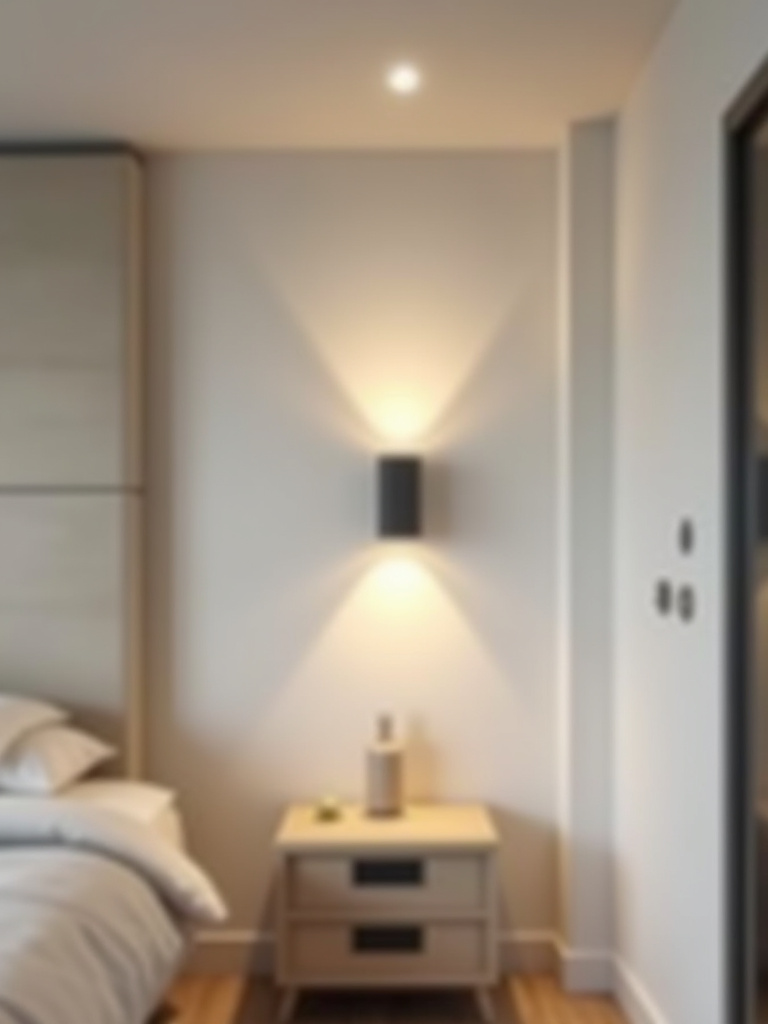
Choose fixtures with simple, sculptural forms: a bare bulb on a fabric cord, a ceramic wall sconce, or a sleek floor lamp. Crucially, install dimmer switches. Dimmers are the most effective tool for controlling ambiance, signaling your body to wind down as light softens.
Always use warm light bulbs (~2700K). Cool, blue-toned LEDs disrupt circadian rhythms and have no place in a restful bedroom. Your lighting should feel like a gentle, warm embrace.
Preserving Calm & Steering Clear of Common Mistakes
You’ve crafted a serene, intentional space, but the outside world constantly threatens to intrude-through mail, new purchases, and gifts. The final phase involves establishing simple, graceful systems to maintain your sanctuary and avoid clutter’s return.
This ongoing practice ensures your bedroom remains a peaceful haven, evolving with you rather than becoming a static relic of a past decluttering effort.
16. Perfect the Art of Concealing Cords
Nothing disrupts serenity faster than tangled cords-visual static noise. Concealing them is essential, not trivial. Though it requires planning, the visual payoff is immense.
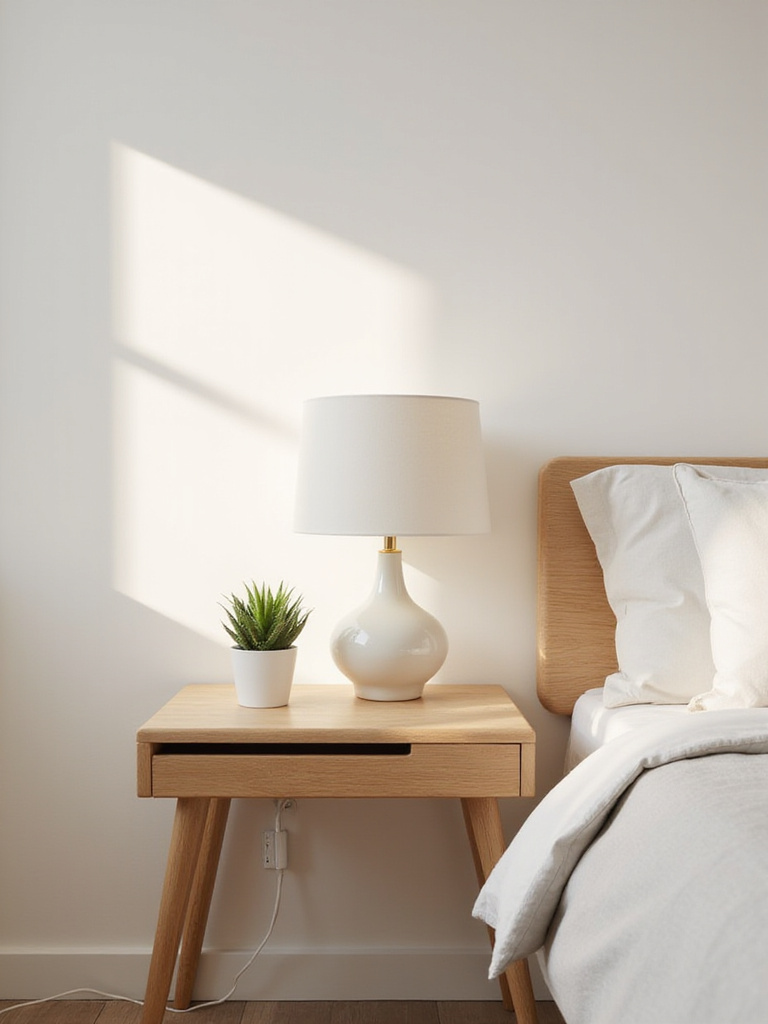
Use fabric cord covers matching wall colors, adhesive clips to route cables discreetly, or cable boxes to hide power strips. Opt for wireless solutions like charging pads when possible. Choose furniture with built-in cord management. When wires vanish from sight, the room feels intentional and peaceful, signaling meticulous attention to detail.
Think of cords as the plumbing of our digital lives-they deserve graceful concealment just like pipes.
17. Create a Daily “Reset” Ritual to Prevent Clutter Build-Up
Your bedroom deserves to be “put to bed” each night, mirroring your own routine. This brief, five-minute habit makes a significant difference. Before sleeping, tidy up: return books to shelves, place worn clothes in hampers, clear water glasses, and smooth the duvet.
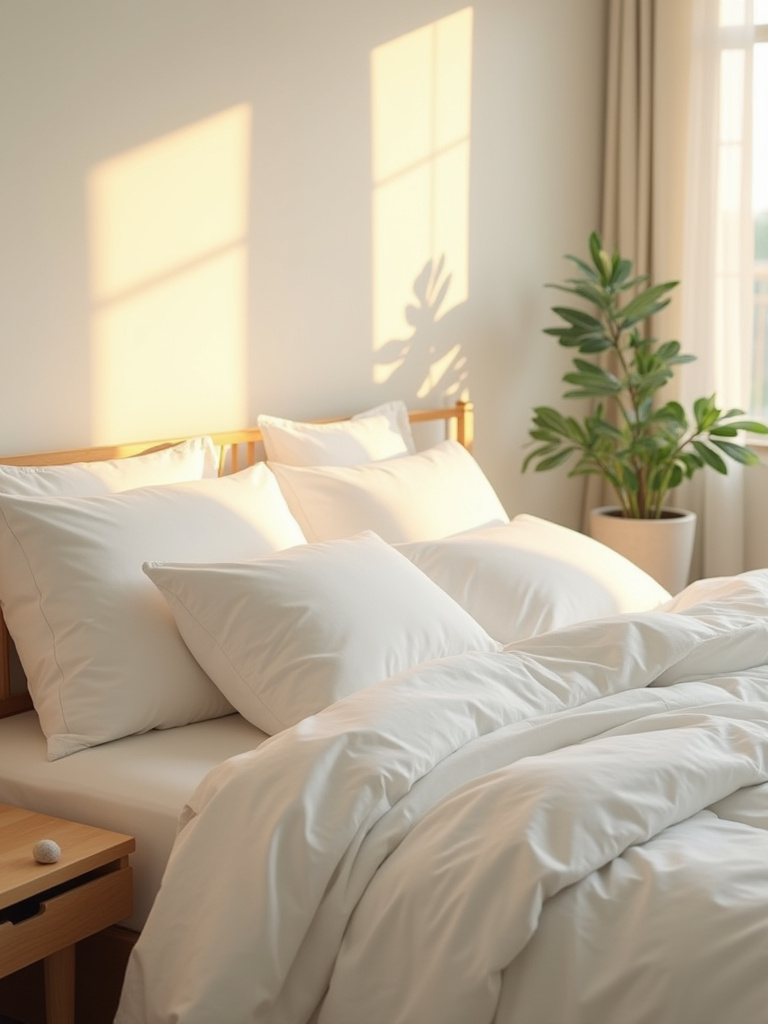
This small act prevents minor messes from escalating. Waking to a clean, calm room is a gift to your future self, setting a peaceful tone for the day. Spending five minutes nightly is far more effective than weekend cleaning marathons.
Consider it a mindful gesture honoring your space and well-being, closing the day and preparing your sanctuary for rest.
18. Beware of “Surface Minimalism” with Hidden Clutter
Here’s a crucial insight: the state of your closets and drawers matters as much as visible surfaces. “Fake minimalism”-clear floors but overstuffed drawers-is self-deception. Though out of sight, clutter creates subconscious stress.
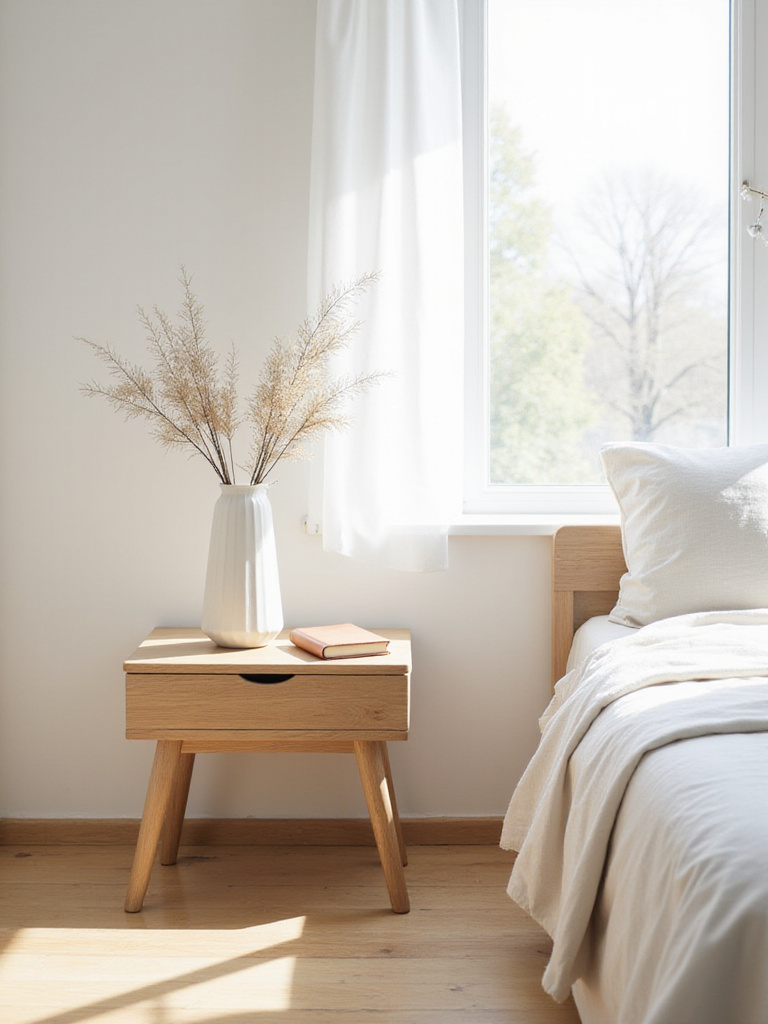
True calm arises from orderliness both seen and unseen. Use drawer dividers and elegant boxes to organize interiors. Avoid using closets as dumping grounds. Opening a drawer to find everything neatly arranged and accessible is a profound pleasure.
Apply the same intentional care to private storage as to public spaces. This distinction separates rooms that merely look minimalist from those that genuinely feel peaceful.
19. Regularly Reassess Your Needs to Sustain Minimalism
Your life evolves, and so should your home. Minimalism isn’t a fixed destination but a continuous practice. Items that serve you now may not in the future. Hobbies, work, and family dynamics change. Periodic reflection on your belongings is essential.
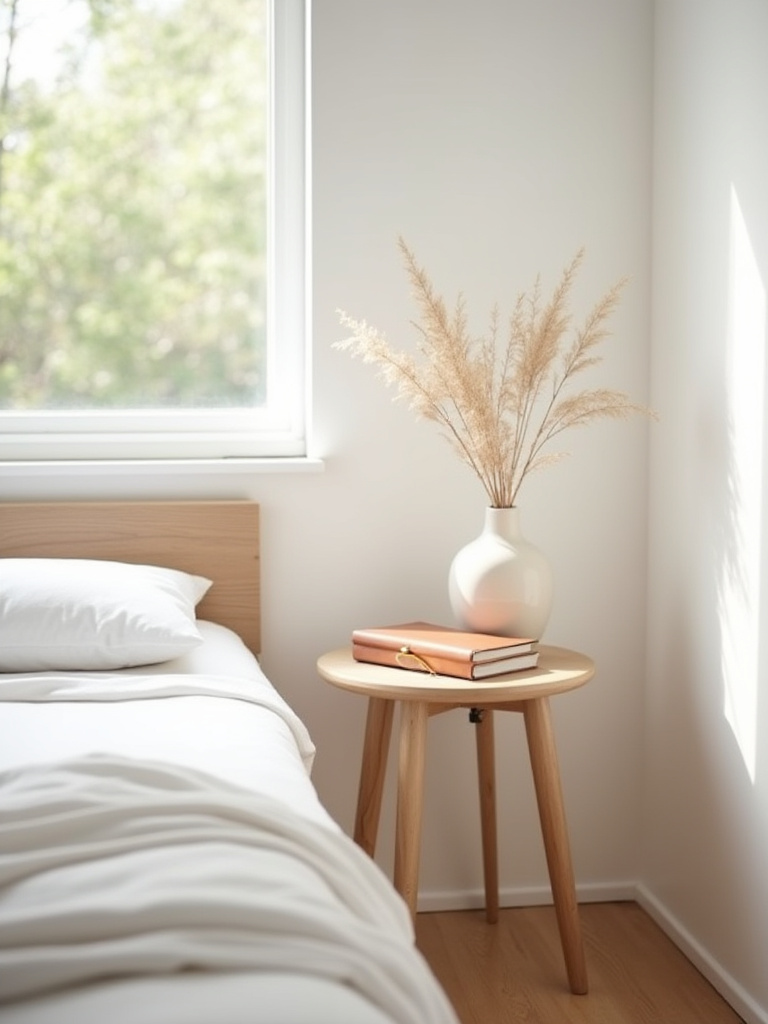
Once or twice yearly, conduct a gentle audit. Review your wardrobe and drawers. Do these items align with your current life or reflect a past self? This isn’t about drastic purges but ongoing dialogue-releasing what no longer serves to welcome what’s next.
This practice keeps your bedroom a living, breathing space that supports you fully, not a museum of former identities.
Final Thoughts
Minimalism isn’t synonymous with stark white walls or barren rooms. It’s about warmth, intention, and crafting a sanctuary that silences external chaos. This guide isn’t a rigid rulebook but a philosophical framework. The aim is to cultivate a personal bond with your space, shaping it into a nurturing, restorative environment. By blending climate-responsive wisdom from ancient traditions with the clean simplicity of modern design, you can create a bedroom that transcends beauty-it becomes essential.
Begin modestly. Select one principle that resonates-perhaps clearing your nightstand or choosing sheer linen curtains-and start there. Each mindful choice brings you closer to a calmer mind and more restful life. Your bedroom is your most intimate space; it deserves to be your most peaceful.

